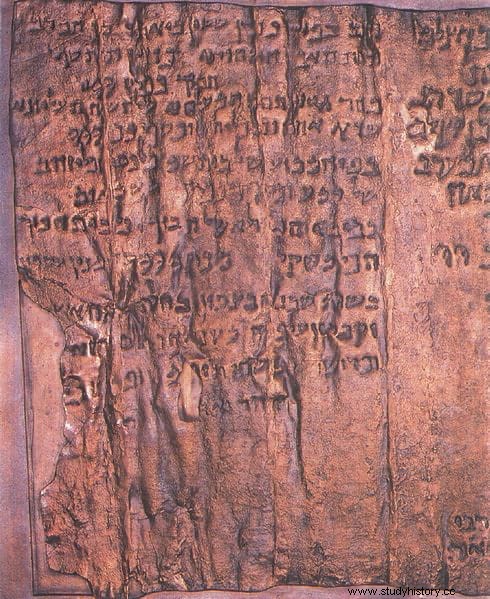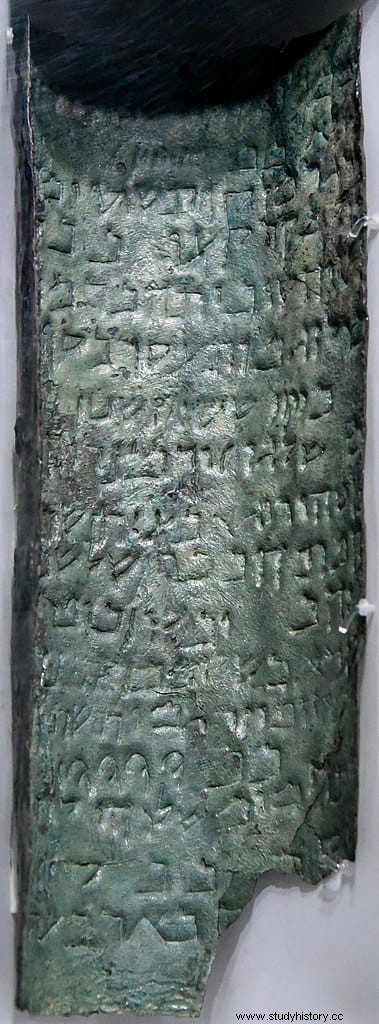In 1947, two Bedouin shepherds who were trying to rescue one of their goats, which had fallen into a chasm in the Qumran Valley (present-day Israel), found some ceramic pots containing seven parchment scrolls. They sold them in pieces to a couple of antique dealers in Bethlehem and, as usually happens in these cases, some of them were circulating from hand to hand until in 1954 they ended up in the hands of an archaeologist from the Hebrew University of Jerusalem, who noticed its historical value and encouraged the search for other similar pieces. In this way, over time some six hundred parchments were found plus many other loose fragments. They are what we know today as the Dead Sea Scrolls.
As I say, most are made of parchment (a support of smoothed animal skin) and papyrus (a kind of paper made from pressed leaves of that plant), but there is one that is different:the one known as Copper Scroll , obviously because it is written on a long sheet of that metal (although with a tiny proportion of tin, one percent). To be exact, they are two rolls with a single text, arranged in twelve columns and engraved on three very thin sheets eighty centimeters long by thirty wide, which originally formed a unit of two meters forty in length. It was discovered on March 14, 1952, during archaeological excavations at the bottom of Cave 3 of Khirbet Qumran, from which another fifteen scrolls of parchment had already been removed, hence its technical name 3Q15.
As you might imagine, the metal had suffered from the corrosion of millennia, making it impossible to unroll it and read its contents. For that reason, archaeologist and Dead Sea Scrolls specialist John Marco Allegro recommended to the Jordanian government (Cave 3 was on their territory and the scroll is on display today in the Amman Archaeological Museum) to send it to England, to Manchester University's College of Technology, where they could subject the piece to a suitable treatment. Indeed, Professor H. Wright Baker cut it into twenty-three sections that made it easy to open, read, and translate.

The work lasted two years, but in 1956 they were ready and Allegro himself, who had supervised them, was in charge of part of the transcription, finally published in 1960. However, the first to deal with the text was the Polish priest Józef Milik, a an expert on the subject who had already worked with the scrolls at the beginning of the decade, when he was still a student at the Pontifical Biblical Institute in Rome. Milik's first impression was that the authors had been the Essenes, although it seemed like an unofficial work because what the scroll said did not resemble what the others had.
These used to contain narratives of a literary-folkloric nature and, in fact, that is what it seemed at first. But Milik later changed his mind:he didn't look like an Essene - nothing indicated it - nor was he probably part of his community, no matter how much it was taken from a cave in his environment; in fact, it was only then that it began to be significant that the scroll was kept at the back of said grotto, away from the rest of the documents. In sum, Milik suggested that it was a sacred text with a different chronology than the other scrolls.
At the same time, the Jordanians had asked Allegro to also work on it and in 1957 he was officially assigned the task. Since Milik had not yet published his results, Allegro transcribed the texts of each copper segment by hand - since they were illegible in photography - and translated them, publishing his version in 1960. Milik would do the same two years later. Allegro's book received harsh criticism from the academic community because it spoke of a Master of Justice (an outstanding and indefinite personality referred to in the Dead Sea Scrolls) who would have been crucified, something refuted by many specialists, although others fragments were admitted, such as the one referring to a hidden treasure (Allegro even organized an expedition in search of it, returning empty-handed).
To a large extent, all this confusion was motivated by the age of the scroll and the language used. The dating is not unanimous and some proposals point to the segment 25-27 AD, while the majority consider it later, around the years 70-135 AD. In fact, there are those who suggest that the aforementioned treasure would be the one accumulated between the two Jewish-Roman wars, which ended with the Temple of Jerusalem in ruins and its assets evacuated or plundered. Milik proposes around AD 100, which implies that it would not be an Essene document because by then the Qumran community no longer existed.
Regarding the second question, the idiomatic one, it also distinguishes the Rollo de Cobre of the other manuscripts. If these were written in a Hebrew that can be classified as biblical, the one that concerns us is in a variant called mishnah , of a rather legal nature; only the 4QMMT roll maintains linguistic similarities. For this reason, the spelling is unusual, with Greek alphabetic and structural elements, and the writing technique presents characteristic forms, the result of having been applied with a chisel. In addition, it is believed that it is a copy made by a scribe who did not speak the original language, hence the numerous confusions recorded and the problems for current researchers.

Even so, it has been possible to determine that it is a list of sixty-four places where the gold and silver objects that made up the temple's treasure were hidden, which gives a clue to the fabulous dimensions it would have. Of course, there is also no unanimity in identifying it with the Second Temple of Jerusalem (the one assaulted by the legions of Titus) and alternatives are proposed such as the First Temple (the one that Nebuchadnezzar destroyed in 586 BC, perhaps with too much chronological difference) or the Qumran community itself (although it is assumed that the members did not have wealth due to their ascetic lifestyle, perhaps they did admit it as a community for a future of splendor); there are even those who believe that it is a mere fantasy, although that would not square with the fact that copper was chosen to engrave the instructions in a more lasting way.
The Copper Scroll It also has references to other places where manuscripts were kept, to priestly vestments and even mentions at the end a document -so far not found- that is considered a Silver Scroll. The transcript cites specific places, such as the House of Hakkoz (who was one of the treasurers of the Temple), the Shaveh cistern or the Cave of Letters (a grotto in the Judean desert where messages exchanged between Simón Bar Kojba, the leader of the rebellion against Rome in 132 A.D., and its followers) and even specifies the number of talents in each one.
The translation of the first column of the scroll reads like this:
Now, even assuming that the Copper Scroll is a kind of treasure map - and most experts agree -... the fact is that there is no trace of it. Why? Today it is impossible to know. All ad hoc searches Following the written instructions they have failed, which leads many to speculate with the most diverse theories:that the Romans found it even then, simply by torturing those responsible; that if the Templars did it during the Crusades and from there became the proverbial wealth of the order; etc. Surely there are lots of novels circulating in bookstores with other hypotheses, each more audacious.
